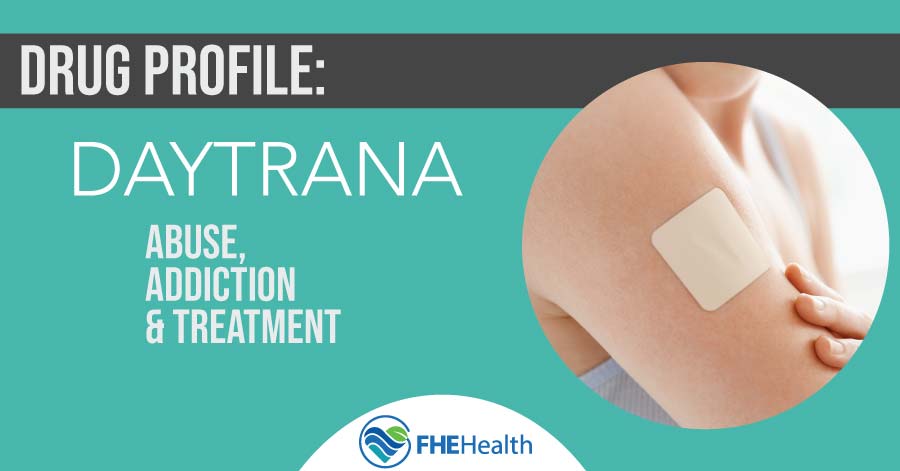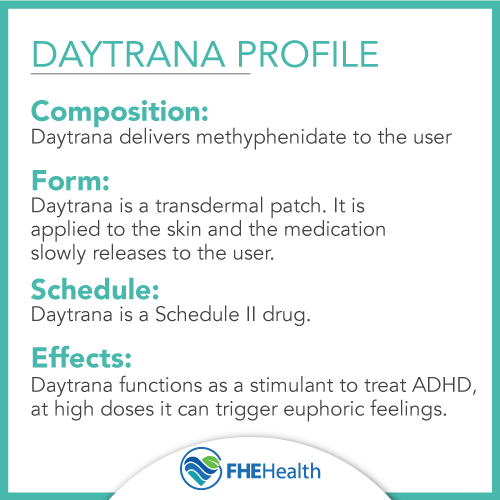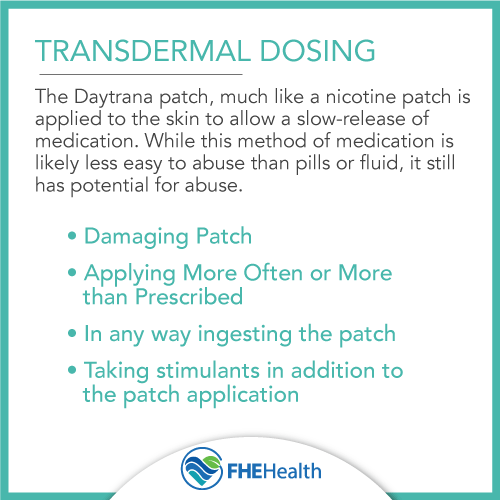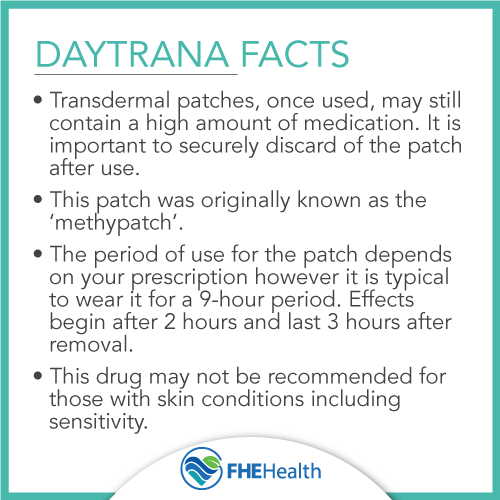
|
|
Approved for use in April 2006 by the Federal Drug Administration, Daytrana is a skin patch produced and marketed by Noven Pharmaceuticals. The drug is also a “methyphenidate transdermal system” (MTS). Daytrana is most commonly used as a daily treatment for “attention deficit hyperactivity disorder” (ADHD) in children ages 6 to 17 years old. When oral medication treatments are not well-tolerated or shown to be ineffective, Daytrana is often a second line of treatment.
When Noven originally submitted Daytrana to the FDA for approval, the recommended duration of use (via wearing the patch) was 12 hours. The FDA rejected the duration, and Noven resubmitted with an updated nine-hour duration. There are currently no generic versions of the drug available.
Daytrana is meant to be applied to a clean, dry surface of the body, usually the hip area. When applied firmly with pressure applied for 30 seconds, the patch is designed to stay on even while swimming or bathing. There is a two-hour delay between when the patch is applied and when the medication begins to work. After nine hours, the patch should be removed and safely disposed of.
It is recommended that the patch be applied on opposite sides of the body from day to day— and be immediately replaced if the patch should fall off. Application of the patch requires adult supervision.
Daytrana is very similar to other common ADHD treatment drugs in its microbiological structure. Like other ADHD drugs, Daytrana is a stimulant. Classified as Schedule II controlled substances, stimulants are considered to be habit-forming (meaning they can lead to dependence and tolerance over time). Because Daytrana is a transdermal patch, it is often a recommended alternative for children who struggle to take oral medication.
What Is Daytrana?
 Daytrana is a stimulant that is released from a transdermal patch typically applied to the hip region. The stimulant is absorbed into the skin. Stimulants, such as Daytrana, influence the parts of the brain and central nervous system that regulate impulses and hyperactivity.
Daytrana is a stimulant that is released from a transdermal patch typically applied to the hip region. The stimulant is absorbed into the skin. Stimulants, such as Daytrana, influence the parts of the brain and central nervous system that regulate impulses and hyperactivity.
The Centers for Disease Control and Prevention (CDC) reports that 11 percent of children in the United States between the ages of 4 and 17 have been diagnosed with either ADHD or ADD. These numbers are predicted to continue rising. It is reported that 6.1% of U.S. children take some kind of prescribed stimulant medication.
Daytrana is less frequently abused than other stimulants, such as Ritalin, mostly because the transdermal patch releases the drug more slowly than oral medication. However, misuse of the patch can occur, and can cause a dangerously high build-up of methylphenidate in the body and toxicity. Chewing, sucking, or swallowing the patch are examples of such misuse.
Misuse of Daytrana is higher in patients with previous substance abuse or suicidal impulses and in impulsive or oppositional patients. Street names for Daytrana are interchangeable with those for Ritalin. The most common street names are “kiddy coke,” “poor man’s coke,” “uppers,” “speed,” and “coke junior.” Usually, though, Daytrana is known to be a “last resort” for those addicted to stimulants, since the patch is more difficult to extract high doses from and is more difficult to abuse.
What Is Daytrana Used For?
Daytrana is exclusively approved and prescribed for ADHD in children. As previously mentioned, Daytrana is a common alternative for Ritalin with children who experience harsh side effects with oral medication. Potential drug interaction issues for children taking Daytrana include adverse reactions for patients who have recently taken MAO inhibitors, vasopressor agents, or antidepressants. Severe anxiety and Tourette’s Syndrome will also preclude a patient from safely taking Daytrana. Daytrana is not recommended for patients who experience skin conditions or who suffer from anxiety disorders.
Is Daytrana Safe?
 Daytrana is not safe to prescribe to people suffering from depression, anxiety, or Tourette’s Syndrome. It is also known to produce the following negative effects:
Daytrana is not safe to prescribe to people suffering from depression, anxiety, or Tourette’s Syndrome. It is also known to produce the following negative effects:
- Skin irritation on patch application site
- Severe anxiety
- Insomnia
- Nausea or vomiting
- Dizziness
- Tics
- Loss of appetite
- Stomach pain and disruptions to normal bowel
- Mood swings
- Hives
- Chest pain
- Trouble breathing
Major side effects have also been reported and can include a dramatic stunt in growth, blurry vision, heart attack, stroke, issues with circulation, seizures, psychosis, and aggression. It is recommended that when using the skin patch, you avoid sun and heat exposure, as heat can cause the release of too much medication at a time. In some cases, permanent skin discoloration may occur.
What is Daytrana Addiction?
As with any stimulant addiction, Daytrana has an addiction liability. Methylphenidate is used in high doses as a recreational drug and can have strong addictive potential. Similarly, Daytrana has the potential to create a euphoric feeling when taken at high doses, triggering the brain’s pleasure and reward system.
How do you know if you or your loved one is addicted to Daytrana? You may notice some or all of the following common signs:
- Dilated pupils
- Restlessness
- Hyperactivity
- Weight loss
- Profuse sweating
- Deceptive behavior
- Aggressive behavior
- Doctor shopping
- Mood swings
- Racing thoughts
- Increased sense of confidence
Stimulant abuse of any kind leads to negative consequences. Stimulants, including Daytrana, can have long-lasting consequences for cardiac health.
How Do You Treat Daytrana Dependence Disorder?
 People with a Daytrana abuse problem can struggle to function normally without the drug, and may have a diagnosable addiction that is manageable with treatment. Overcoming addiction to stimulants like Daytrana typically requires a detox period at an inpatient treatment center. Ongoing outpatient therapy is also recommended. Daytrana can remain in urine for up to two days following the most recent dose, and can show up in blood samples for about 24 hours.
People with a Daytrana abuse problem can struggle to function normally without the drug, and may have a diagnosable addiction that is manageable with treatment. Overcoming addiction to stimulants like Daytrana typically requires a detox period at an inpatient treatment center. Ongoing outpatient therapy is also recommended. Daytrana can remain in urine for up to two days following the most recent dose, and can show up in blood samples for about 24 hours.
During detox from Daytrana, your withdrawal symptoms may be severe. Recovering users commonly report that they experience a dysphoric mood, or general unhappiness, during withdrawal. Other commons withdrawal symptoms include:
- Jittery reactions
- Chills
- Sweats
- Anxiety
- Dulled sense
- Slurred or slowed speech patterns
- Slow heart rate
- Impaired memory
- Body aches
- Cravings
- Nightmares
- Depression
For patients who have battled ongoing depression, withdrawal symptoms can be especially severe. Symptoms can occur as early as within a few hours of last taking Daytrana, and can continue for several days and even weeks.
If you or a loved one suspect that you may be experiencing Daytrana addiction, don’t be afraid to reach out for help. Contact an FHE addiction counselor today, by calling us at (866) 299-0618. Our compassionate team of counselors are standing by to take your call 24/7. Start your journey to recovery today!






